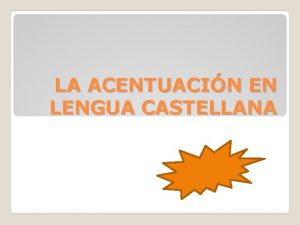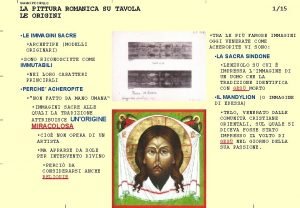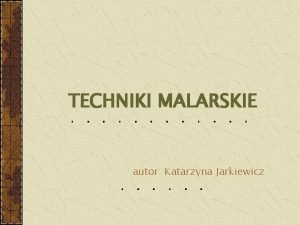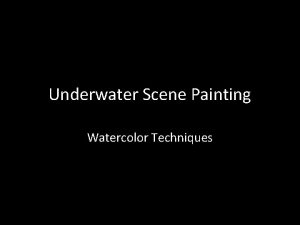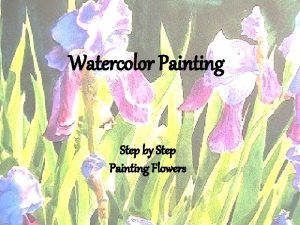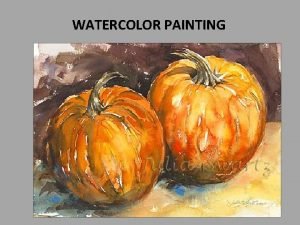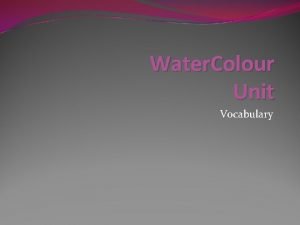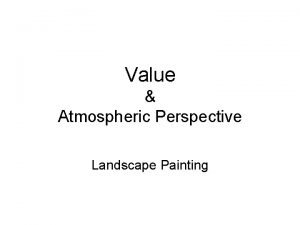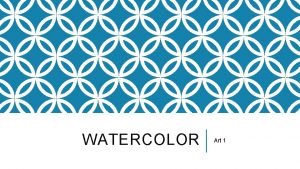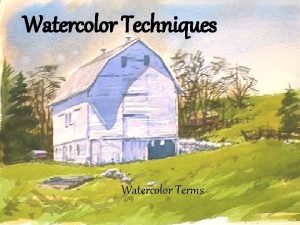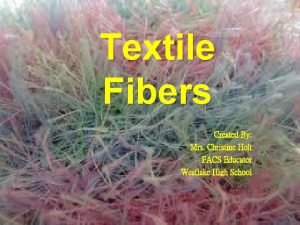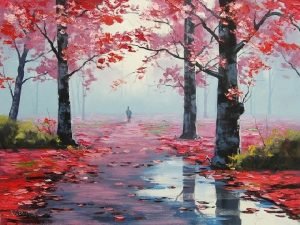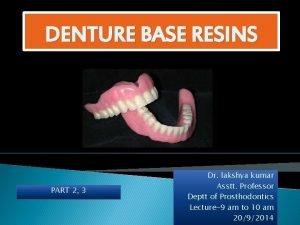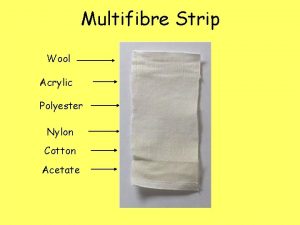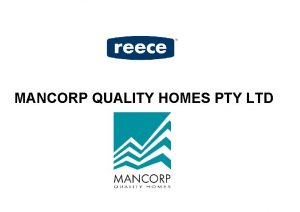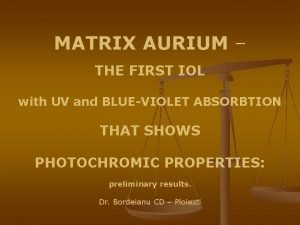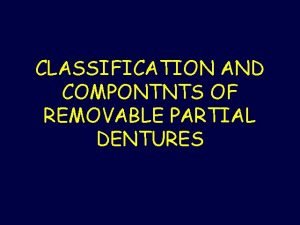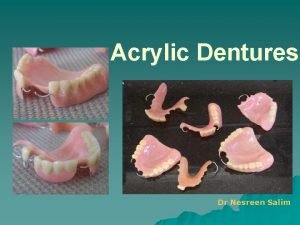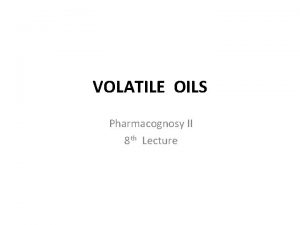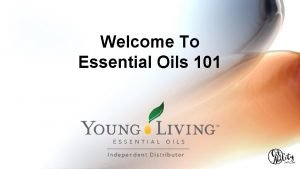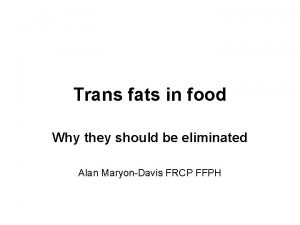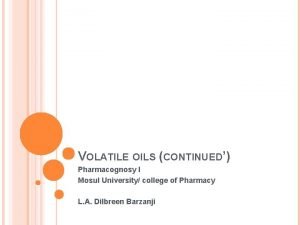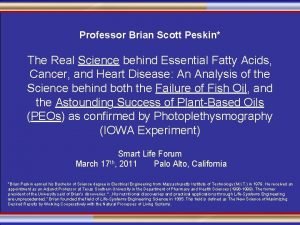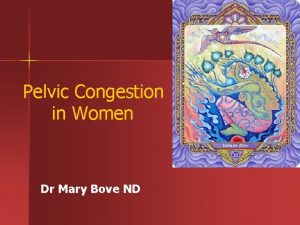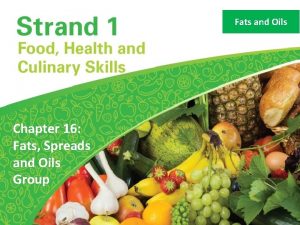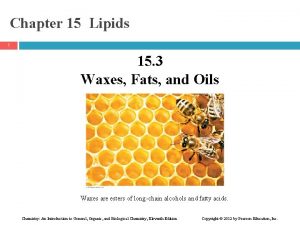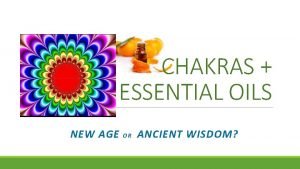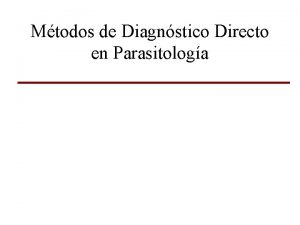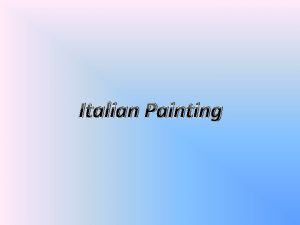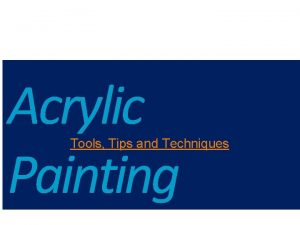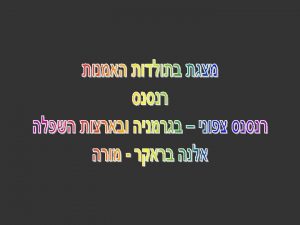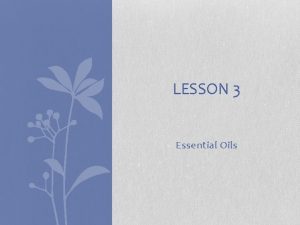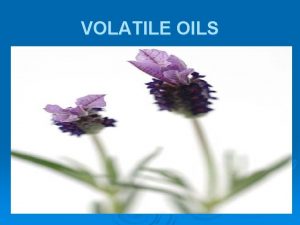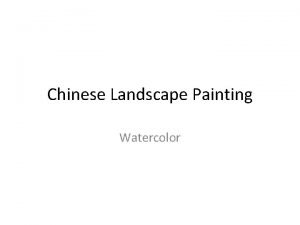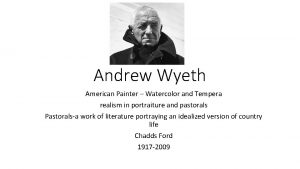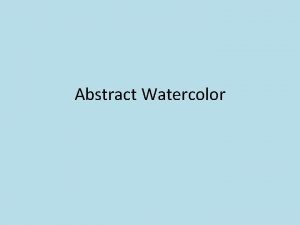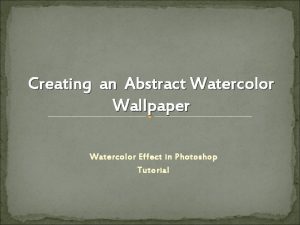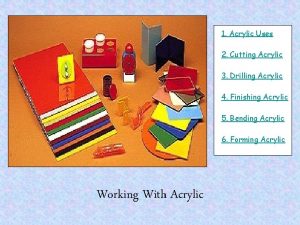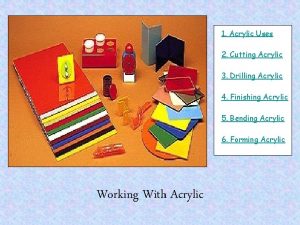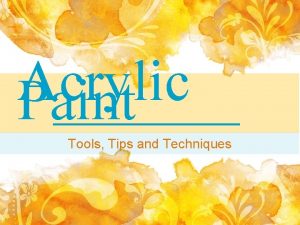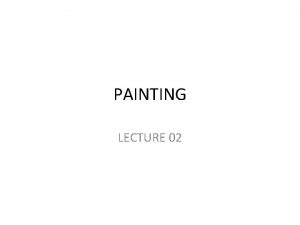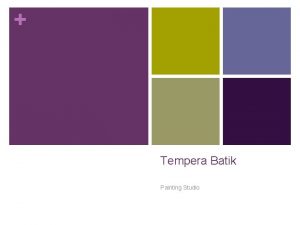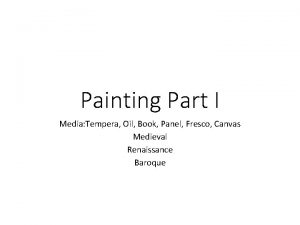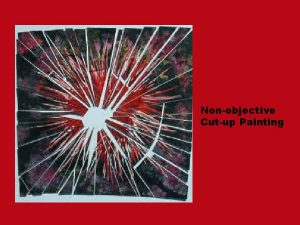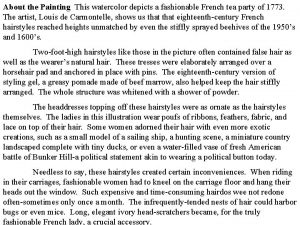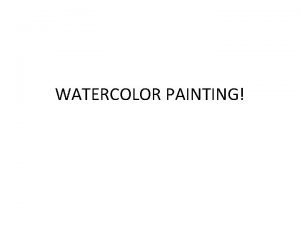Painting Encaustic Fresco Tempera Oils Watercolor Gouache Acrylic



































- Slides: 35

Painting Encaustic Fresco Tempera Oils Watercolor Gouache Acrylic Collage & Mosaic Off The Wall!

. • Earliest cave paintings • Natural pigments obtained from • Plants and nearby deposits of minerals and clays • Blacks from charred wood • Rembrandt’s time (17 th cent) • Mixed finely ground William Harnett. A Smoke Backstage. 1877. Oil on Canvas. 7”x 8” pigments with oil by hand until paint reached desired consistency • Today paints packaged in tubes or jars, ready to use

Terms • Pigment • Powdered substance that provides color in paint • Binder • Ingredient that ensures paint will adhere to surface • Medium or Vehicle • Liquid that holds particles of pigment together without dissolving them • Aqueous Media • Diluted with water • Watercolors • Nonaqueous Media • Require other dilutents • Oil Paints

Terms • Support • Canvas, paper, wood panel, wall or other surface on which artist works • Ground or Primer • Preliminary coating • Gesso • Mixture of white pigment and glue that seals support.

Vehicles and Binders • Oil Paint • Vehicle • Turpentine or its substitute • Binder • Linseed Oil • Tempera (traditional) • Vehicle • Water • Binder • Egg Yolk • Fresco • Vehicle • Plaster • Binder • Lime in plaster • Watercolor • Vehicle • Water • Binder • Gum Arabic • Resin from Acacia tree • Acrylic • Vehicle • Water • Binder • Acrylic Resin • Encaustic • Vehicle • Hot beeswax • Binder • Resin

Encaustic • Encaustic paints consist of pigment mixed with wax and resin. • The technique was important during ancient Greece ( the word encaustic comes from the Greek for “burning in”) • When the colors are heated, the wax melts and the paints can be applied freely. • The earliest examples are funeral portraits created during the first centuries of our era in Egypt, which was under Roman rule at the time.

Young Woman with a Gold Pectoral, from Fayum. 100 -150 C. E. Encaustic on wood, height 12 ½”

Jasper Johns. Flag. 1954– 55 Encaustic, oil, and collage on fabric mounted on plywood (three panel 42 1/4 x 60 5/8"

Fresco • Pigments mixed with water and applied to plaster support (wall, ceiling) • Fresco Secco • “dry fresco” – dry plaster • Buon Fresco • “true fresco” – wet lime plaster • Wall painting technique • large-scale murals • Cartoon • Full-size drawing of project Michelangelo Sistine Chapel • Ancient Mediterranean, China, India, Mexico • Italian Renaissance

Ex. of a cartoon

Raphael. The School of Athens. 1510 -11. Fresco, 26 x 18’, Stanza Della Segnatura, Vatican, Rome

Diego Rivera. Mixtec Culture. 1942. Fresco. 16’ 1 ½ x 10’ 5 5/8”

Tempera • Shares qualities of watercolor and oil paint • Aqueous medium but dries to strong, insoluble film • Retains brilliance and clarity for centuries • Vehicle is an emulsion • Egg yolk, casein (derivative of milk) • Dries quickly • Andrew Wyeth • Jacob Lawrence

Andrew Wyeth. That Gentleman. 1960. Tempera on panel, 23 ½ x 47 ¾”

Jacob Lawrence. Cabinet Maker. 1957. Casein tempera on paper, 30 ½” x 22 ½”

Jacob Lawrence. Self. Portrait. 1977. Gouache on paper Gouache • Watercolor with inert white pigment added • Inert pigment is pigment that becomes colorless or virtually colorless in paint • It makes colors opaque • Poster paint • Well suited for large areas of flat, saturated color

OILS • Oil paints consist of pigment compounded with oil, usually linseed. The oil acts as a binder, creating as it dries a transparent film in which the pigment is suspended. • Jan van Eyck, a 15 th century Netherland artist was claimed to have invented oil painting. • He did not invent it but he can be credited with understanding & exploring its possibilities.

• Most artists painted on wood panels when oil paints were introduced. • • • A switch from wood to canvas Changing styles favored larger paintings. Wood panels were heavy and would crack, linen canvas could be stretched to almost any size. As artist came to serve distant patrons, their canvases could be rolled up and shipped safely. • • A characteristic of oil paint is it dries very slowly. This creates advantages & disadvantages for the artist. • Advantages- colors could be blended subtly, layers of paints can be applied on top of other layers with little danger of separating or cracking, and the artist could rework areas of the painting forever. Disadvantages- oils dries so slowly-if pressed for time this is a problem. Oils could take weeks or months to dry. • • • Glazes—thin translucent veils of color applied over a thick layer of underpainting. Impasto- any thick application of paint.

Jan van Eyck. Man in a Red Turban (Self. Portrait? ). 1433. Tempera and oil on panel, 13 1/8 x 101/8”

Jean-Auguste Dominique Ingres. La. Comtess d’Haussonville. 1845. Oil on canvas, 51 7/8” x 36 3/16” Grisaille • French for “gray” Entire painting in black and white, colored glazes floated over image whose lights and darks show through as modeling

Berthe Morisot. Girl Arranging Her Hair (“the Bath”). 1885 -86. Oil on canvas, 35 ¾” x 28 ½” Alla Prima • Italian for “all in one go” – completing a painting in a single session • Berthe Morisot • Broken Color • Individual strokes of color • Impasto • “Paste” in Italian, where paint is layered thickly on canvas

Watercolor • Watercolor consists of pigment in a vehicle of water and gum arabic, a plant substance that acts like a binder. • The primary characteristic of watercolors is transparency. • Most common support is paper • Transparent • Applied in thin washes • John Singer Sargent and Winslow Homer • Classic technique • Carolyn Brady • Photorealism • Elizabeth Peyton • Makes use of white paper

John Singer Sargent. Mountain Stream. C. 1912 -14. watercolor and graphite on paper, 13 ¾” x 21”

Elizabeth Peyton, Pierre (Tony), 2000. Watercolor on paper, 26 3/4" x 40

Acrylics • Synthetic Colors or Polymer paints: consists of acrylic resin, polymerized through mixture in water. • When acrylic paint dries , the resin particles combine to form a waterproof film. • Depending on how its used, acrylics can mimic the effects of oil paint, watercolor, gouache, and tempera.

David Hockney. Mount Fiji. 1972. Acrylic on canvas, 60 x 48”

Takashi Murakami. The Castle of Tin. Acrylic on canvas on board, 10 x 10’

BLURRING THE BOUNDARIES Collage is a French word that means “pasting” or “gluing. ” Attach actual objects such as paper or cloth to the surface.

Pablo Picasso. Guitar, Sheet Music, and Glass. 1912. Pasted paper, gouache, and charcoal, 18 7/8” x 14 ¾’

Fred Tomaselli. Head. 2002. Photocollage, gouache, acrylic paint, and resin on wood panel, 11 x 11”

Romare Bearden. Mysteries. 1964. Collage, polymer paint, & pencil on board, 11 ¼ x 141/4”

OFF THE WALL Polly Apfelbaum Matthew Ritchie

Polly Apfelbaum. Big Bubbles. 2001. Synthetic velvet, fabric dye; 18’; 1, 040 separate pieces.

Big Bubbles. 2001

Matthew Ritchie "Parents and Children“ (Installatio n view) 2000
 Tempera lleva tilde
Tempera lleva tilde Tempera simulada
Tempera simulada Tempera su tavola romanica
Tempera su tavola romanica Rodzaje technik malarskich
Rodzaje technik malarskich Underwater scene painting
Underwater scene painting How to paint spring flowers in watercolor
How to paint spring flowers in watercolor William blake watercolor
William blake watercolor Watercolor vocabulary
Watercolor vocabulary Landscape atmospheric perspective
Landscape atmospheric perspective Watercolor vocabulary
Watercolor vocabulary Watercolor terms
Watercolor terms Kckcc
Kckcc Acrylic fabric advantages and disadvantages
Acrylic fabric advantages and disadvantages Bracing in rpd
Bracing in rpd Emulsion acrylic adhesive
Emulsion acrylic adhesive Internal porosity of denture base
Internal porosity of denture base Multi fiber fabric strip
Multi fiber fabric strip Posh solus 2000365
Posh solus 2000365 Matrix acrylic aurium
Matrix acrylic aurium Internal occlusal rest
Internal occlusal rest Bifid spoon denture
Bifid spoon denture Non polar molecules that include fats oils and cholesterol
Non polar molecules that include fats oils and cholesterol Volatile oils - pharmacognosy
Volatile oils - pharmacognosy Essential oils
Essential oils Hydrogenation of oils
Hydrogenation of oils Uses of volatile oil in pharmacognosy
Uses of volatile oil in pharmacognosy Brian peskin
Brian peskin Carmen bove
Carmen bove Owensboro grain prices
Owensboro grain prices Fats, oils, and waxes
Fats, oils, and waxes Definition of lipids
Definition of lipids Fats spreads and oils
Fats spreads and oils Chapter 15
Chapter 15 New age oils
New age oils What biomolecule transports substances in and out of cells
What biomolecule transports substances in and out of cells Xenodiagnóstico
Xenodiagnóstico
